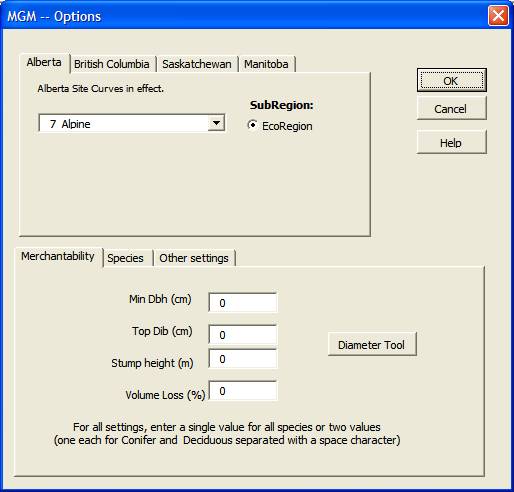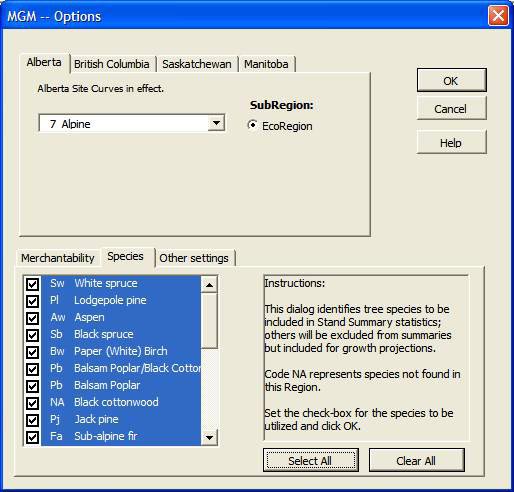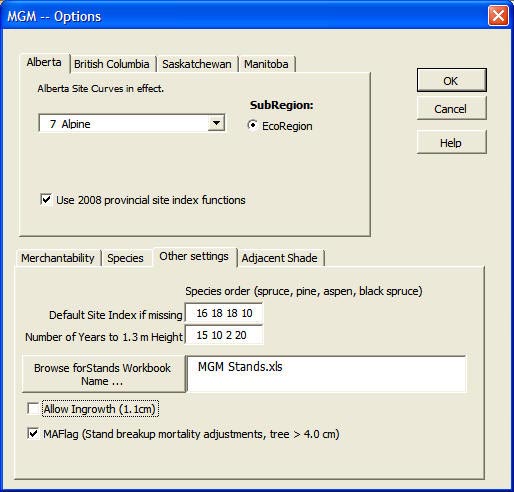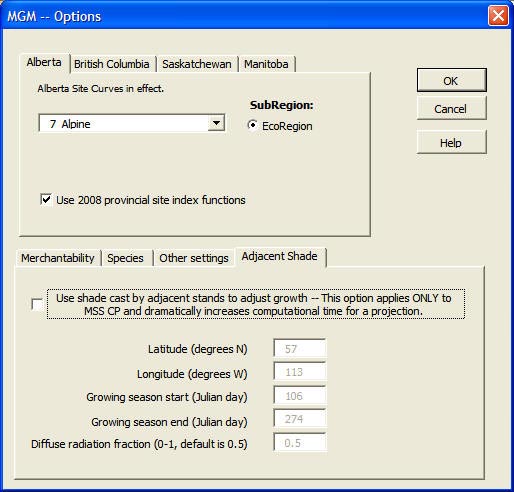Edit: Dialog
Insert: Yes
Delete: Yes
Action: Sets the major regional, utilization and other MGM options. The Options event may be placed immediately before the first Crop Plan event or just after a Crop Plan event. Options setting remain in effect until another Options event is encountered. This allows options to be set once for several Crop Plans.
In limited circumstances (e.g. when in-growth is expected only in later life of a stand or when the volume loss may change over the life of the stand), it may be necessary to insert an Options event within a single crop plan. If this is required, special care is needed to ensure that the all options are consistent (e.g. inDBH, stump height, etc) and this may require additional editing. When an Options event is inserted within a Crop Plan, no age/year is inserted. To update these and allow editing of the Options event, the previous Establish event must be edited (ending with "OK") so that years and dates are updated. Then the Options event can be edited. Remember also to reset the Options as needed for Crop Plans that may follow the one with special Options.

Four regional Variants of are available for MGM: British Columbia, Alberta, Saskatchewan, and Manitoba. Localization features for each Variant include modifications to allow for: species codes, site index curves, tree volume estimation functions, and growth functions or other variations requested by local users (none currently implemented). Currently all Variants use the same growth and mortality functions. It is assumed that species codes for trees will reflect the Region that has been specified in the Options event for a Crop Plan.
Region selection affect the estimation of tree volumes and the height growth indirectly by the local site index function. Since height growth also influences Dbh increment and survival, there will be other differences in growth projections for the different regions.
For variant information for each province, select the desired province:
- British Columbia
- Alberta
- Saskatchewan
- Manitoba
Tree merchantability tab:
Top Dib is the smallest diameter (cm, inside bark) that is considered merchantable.
Stump height (m) is the lowest point of merchantable volume.
Minimum Dbh (cm) is the smallest DBH that is considered merchantable.
Yield reports include only trees larger than the minimum DBH; trees with no DBH ("-1" in the DBH cell for trees where height is < 1.3 m) are also excluded. This means that for young stands, there may be no density or other yield values or that the densities may be less than that specified for stand establishment. The stand worksheet includes summary information for trees not utilized.
Volume loss:
- Volume loss is specified as a percentage (%). The same percentage reduction is made at all reporting ages. The reduction is only applied to the stand volumes and does not affect the growth projections of other tree characteristics. Volume loss may occur for several reasons:
- Individual tree decay, waste,and breakage.
- Gaps in large area stands (sources include insect, disease, wind throw, poor drainage, rock outcrops, steep slopes, etc).
- Some tree species are not utilized; for example white birch. There are two situations where this may occur and they are handled differently within the model.
- With simulation of trees, only the four MGM species are simulated. The means that a species like birch that may not be utilized will never appear in a simulated tree list. The only way to adjust for the assumed presence of birch is to assume that the density and simulated list for aspen includes a proportion of trees that should have been simulated as birch. This proportion of trees can be removed using a loss reduction factor applied to the deciduous tree list. With tree lists obtained from plot data, the peripheral species will also be present and these individual trees must be identified as not utilized.
Two forms of volume loss input are allowed:
- A single value that is applied to all tree species.
- Two values that are applied to the conifer and deciduous tree components in that order.
- An example: "5 15" -- 5% reduction for conifer and 15% reduction for deciduous trees.
Short term projections using real tree lists (e.g. for validation) should not require a volume loss reduction for gaps (exceptions might be for a partially destroyed plot).
Long term projections often are based on average conditions or assumed treatments (like planting at designated densities) with a simulated tree list. MGM assumes that trees are uniformly spaced over the stand area. However, when applying yield projections to large areas of real stands, areas of patchiness always appear. These are absent from the theoretical MGM projections. For this reason a reduction factor of 20-30% is suggested for long term projections to allow for the reductions due to spatial variation (gaps) found in real stands. Additional loss due to decay, waste, and breakage may also be added to the reduction due to gaps.
Justification for Volume loss due to gaps in large area stands and interaction with the inputs to the projection:
- PSP for developing MGM generally selected from fully stocked stands (few or no gaps).
- MGM projections assume the area (plot or stand) is uniformly stocked at the level specified by establishment conditions.
- Inputs from averages of random plots (e.g. TSP) may produce projections that are quite different (often higher) from averages of projections for individual plots since it is likely that the inputs based on averages will indicate less competition and therefore better conditions for growth.
- If inputs are based on averages of actual conditions, un-stocked areas or gaps in the stand are not fully accounted for. In addition, it is likely that averaging where sample size is small may not provide for adequate representation of the un-stocked areas unless the proportion of area un-stocked is large.
- When MGM projections are applied to large area stands rather than individual plots, a reduction factor is needed to reduce yield estimates for these gaps. The overall average of stocked and un-stocked areas is actually a weighted average (for example: 0.8*400 m3/ha + 0.2*0 m3/ha = 320m3/ha).

Species Utilization tab: Check boxes (Checked/Unchecked)
The Species tab provides access to the list of species that may be utilized or ignored. A checkbox setting specifies which species are to be included in stand and yield summaries. Note that utilization is dependent on both species utilization and minimum Dbh.

Other settings tab:
Default site index: a list of 4 site index values separated by spaces, one for each of the MGM species (white spruce, lodgepole pine, aspen, black spruce).
These values are used if site index is not found in stand establishment events.
Number of Years to 1.3 m height: a list of 4 integer values separated by spaces, one for each of the MGM species (white spruce, lodgepole pine, aspen, black spruce).
A list of 4 integer values separated by spaces, one for each of the MGM species (white spruce, lodgepole pine, aspen, black spruce).
If needed, these values are used to fill missing tree age data in stand establishment events.
Allow In-growth: Check box: (Checked/Unchecked)
Checking this box, allows in-growth of trees to occur (the in-growth threshold is currently 1.1 cm DBH) based on the stand age and other characteristics (Qin, 1988). Since this means new trees may be added to the stand, computational time for growth projections can increase substantially. For script development and testing, in-growth is usually left off (unchecked). For additional information see the in-growth discussion under The Model.
Mortality Adjustment factors (MAFlag): Check box (Checked/Unchecked)
These are factors that reflect stand breakup in mainly in Spruce/aspen stands (Yang PhD thesis 2000?). For additional information see the mortality discussion under The Model.
Browse for Stands Workbook Name: Displays a dialog window where user can select the Stands workbook to use for reading Stands from XLS as part of the stand establishment event. In previous versions the Stands workbook name was set using the MGM Toolbar. That method is still available, but the preferred method is to make the setting using the Options event. Having the Stands workbook setting as an Options event setting allows the user to create a series of CP on the same Crop Plan worksheet that can read stands from a collection of workbooks. As with other Options settings this Stands workbook name remains in effect until execution of another Options event changes it.
Displays a dialog window where user can select the Stands workbook to use for reading Stands from XLS as part of the stand establishment event. In previous versions the Stands workbook name was set using the MGM Toolbar. That method is still available, but the preferred method is to make the setting using the Options event. Having the Stands workbook setting as an Options event setting allows the user to create a series of CP on the same Crop Plan worksheet that can read stands from a collection of workbooks. As with other Options settings this Stands workbook name remains in effect until execution of another Options event changes it.

Adjacent Shade tab:
Use shade check box: turns adjustment of growth on/off.
Other settings are explained in the dialog (Latitude, Longitude, Growing season start, Growing season end, Diffuse radiation fraction).
